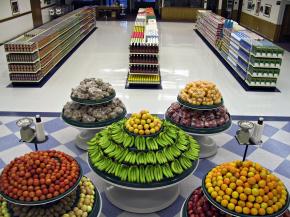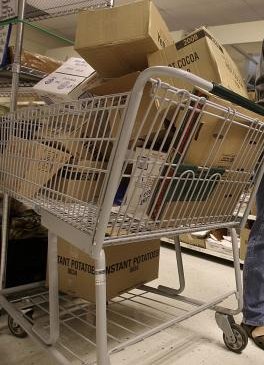Bishop's Storehouses
Since the early days of The Church of Jesus Christ of Latter-day Saintsin the 1800s, Bishop's Storehouses have been a part of the Church. However, up until the 1930s, these storehouses were maintained at the local congregational level only. In 1936, the Church announced what is now known as the Church Welfare and Self-Reliance Program, which is a worldwide program within the Church. This program includes the program known as Bishop's Storehouses.
A Bishop's Storehouse is best described as a supermarket without the cash registers. The storehouse is purposely made to appear like a supermarket, so people going there feel like they are in a regular supermarket. The people who shop here are in need of food; for example, someone may be unemployed and have no money coming in to buy the basic necessities of life. In addition to food, storehouses carry jackets and jeans, towels and sheets. It is up to the Bishop in each Latter-day Saint ward (congregation) to determine if an individual qualifies for food from the Bishop's Storehouse. Although this program is mainly for Church members, it is possible for a non-member to obtain help from a Bishop's Storehouse, if the Bishop deems this appropriate. Also, in times of disaster, such as Hurricane Katrina, larger Bishop's Storehouses known as Regional Bishop's Storehouses were opened to supply victims of Hurricane Katrina with food and other items. Many of the people helped at this time were not Latter-day Saints.
- The bishops’ storehouse at Welfare Square is one of 124 Bishops’ Storehouses in operation worldwide. At Bishops’ Storehouses, individuals in need work with their local leaders to receive food and other items free of charge.
- The Church operates 32 farms, ranches, orchards and processing facilities, which produced over 100 million pounds of food last year, according to the Church’s 2021 annual report. Approximately 36 million pounds were distributed to bishops’ storehouses, while 44 million pounds were donated through community initiatives.
Bishop Gérald Caussé spoke of the modern-day Welfare Program of the Church, noting that it grows food on more than 100,000 acres of land and the food is sent to plants where it is packaged, canned or processed.
“From there, these goods are shipped to over 100 bishops’ storehouses . . . ,” he said.
“In every community, local bishops who know each individual personally meet and work with families — assessing their needs and identifying available resources. They help them to help themselves and reach their goals of becoming self-reliant. For those unable to meet basic needs, the bishop can provide food and other household goods from the bishops’ storehouse. There is no cost for these needed, life-sustaining supplies.”[1]
How is the food transported from the farms to processing centers and canning? The Church transports the food by a fleet of Church-owned trucks known as Deseret Transportation. The Church owns canneries in the United States, Canada, and Mexico. From these canneries, food items can be shipped worldwide.
How are Bishop's Storehouses financed? Every month, generally the first Sunday of the month, Church members are asked to fast for two meals. The amount of money that would be spent for those two meals is contributed to the Church. This is known as a fast offering. The money is used for needs in the local Latter-day Saint congregation and elsewhere. "Elsewhere" could mean almost anything, such as purchasing farmland in Argentina.
“None of this would happen without the generosity of the members who donate of their money, resources and time,” Bishop Caussé said. “It humbles me to see their examples, and this is happening all around the world.”[2]
Where does the labor come from? There are few paid employees at the Bishop's Storehouses. senior missionaries and young service missionaries serve there. Other labor comes from Church members who live in the vicinity of the Bishop's Storehouse who voluntarily serve.
Is there anything expected of those who receive any food or other items from a Bishop's Storehouse? Generally yes. If a man is unemployed, he could be expected to do a service project, such as cutting the lawn at the local meetinghouse, if he was asked to do so by the Bishop. Permanent solutions are especially considered, not just temporary solutions. As an example, if a man were unemployed, the Church would help him find a job through the Church's Employment Resource Centers. Some of the people who are receiving food from a Bishop's Storehouse work at the Storehouse in exchange for the food and other items that they have received. Job training is received while working at the Bishop's Storehouse. Some people have used their skills they learned at the Bishop's Storehouse to find a job.
In areas of the world where there are no Bishop's Storehouses or when a Latter-day Saint congregation is located far away from a Bishop's Storehouse, food and other items would be purchased by the local congregation in order to help the needy. When not practical to have certain items produced from Church farms and processing centers sent to a Bishop's Storehouse, these items would be purchased locally and placed in the Bishop's Storehouse.
External Sources
- Jim Wall, 2004 Church Almanac, published by Deseret Morning News in 2004 at Salt Lake City, Utah, pages 125-144.
- Sarah Jane Weaver, LDS Church News, published week ending August 25, 2007 at Salt Lake City, Utah, by the Deseret Morning News Pages 9-11.
- Inside Church Headquarters: A glimpse into the Church’s welfare and humanitarian efforts

